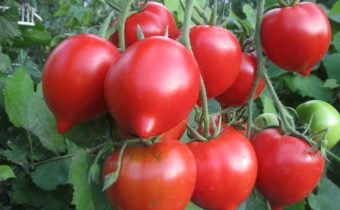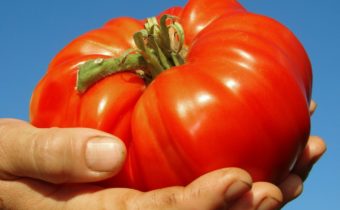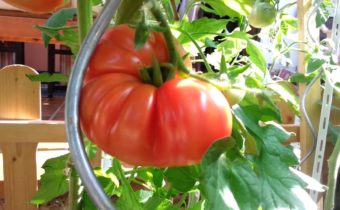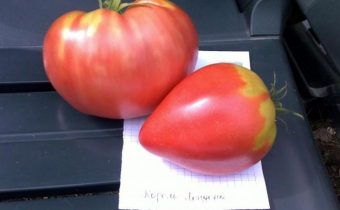Tomatoes "Giant raspberry": a variety with long-term fruiting
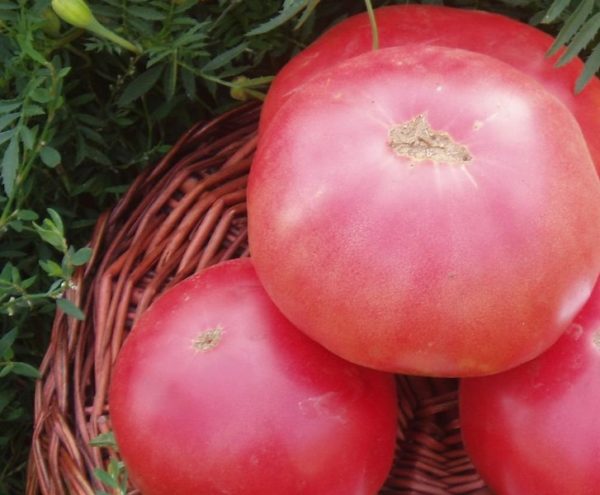
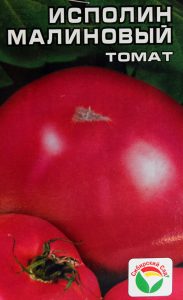 Already spring is on the way, and solanaceous seeds can already be sown on seedlings. What sort of tomatoes to choose, so that they are tasty, beautiful, not very demanding, but fruitful, but the neighbors wonder? Some tomatoes are beautiful, others are tasty, and others are fruitful. But what sort of combines all these requests? And here the description and characterization of the variety, such as the tomato Giant Raspberry, comes to the rescue of the gardener.
Already spring is on the way, and solanaceous seeds can already be sown on seedlings. What sort of tomatoes to choose, so that they are tasty, beautiful, not very demanding, but fruitful, but the neighbors wonder? Some tomatoes are beautiful, others are tasty, and others are fruitful. But what sort of combines all these requests? And here the description and characterization of the variety, such as the tomato Giant Raspberry, comes to the rescue of the gardener.
This tomato has become very popular among fans of large-fruited tomatoes. He practically answers all the requests of tomato lovers, as evidenced by many positive reviews of those who, once having grown a tomato Giant on his plot, now grow it every season.
Characteristics and description of the Giant
This variety is not for nothing called the Giant: it stands out not only the size of its fruits, but also the size of the bush. All indicators of its characteristics exactly match the name of the variety.
Bush Description:
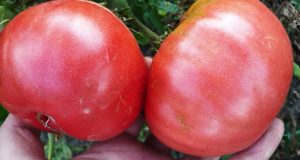
- indeterminate, standard;
- mid-season: fruits ripen on 105-110 days after germination;
- tall: in protected ground about 1.8 m; average specimens grow to 130-150 cm, in the open bed of 1 m - 1.3 m (the growth of the bush depends on the conditions, climate and place of cultivation);
- needs tying up, pasyonkovanii;
- it is possible to form in two stalks, however the best results can be obtained if formed in one stalk;
- it is better to pinch the top when the bush reaches the desired height;
- green leaves, medium size;
- inflorescence type intermediate;
- above the 8–9 leaf, the first inflorescence is laid, followed by every three leaves;
- large-fruited: on average, tomatoes weigh about 300-400 g;
- fruiting long - until autumn;
- high yield: from one bush you can get about 10 kg of tomato.
The fruits of tomato Giant raspberry, too, are impressive for their characteristics:
- the largest tomatoes get weighing about 0.5-0.8 kg;
- on average, tomatoes collect about 300-400 g;
- flat round shape;
- near the stem, the fruit is slightly ribbed;
- ripe tomatoes rich crimson or dark pink color;
- taste high;
- tomatoes are sweet, aromatic, juicy;
- the pulp is fleshy, dense, with pronounced sugar content;
- seed chambers 5-6;
- very few seeds;
- the skin is dense, does not allow the fruit to crack;
- in tomatoes dry matter about 5%, sugars 2.4%;
- do not crack;
- excellent keeping quality;
- confident transportability.
Due to the ability to maintain its high commercial quality when transporting over long distances, the Giant Raspberry tomatoes are very attractive for those who grow tomatoes on an industrial scale. Tomatoes can be safely stored in cool places: room, garage, subfield, balcony (warmed), closet.
Appointment: universal, salad and for technical processing. Giant is tasty in salads, sliced. But also in canning it is successfully used: juices, pastes, ketchups; fruits collected at a time closer to autumn (2nd and 3rd collection) are not so large, they are wonderful for whole-canning.
See also: Description of tomato variety "Bear's paw" and its advantages
Disease and Pest Resistance
Tomato Raspberry Giant has good resistance to many diseases, characteristic of the family of the nightshade.
Diseases
There is, however, a chance of becoming ill.
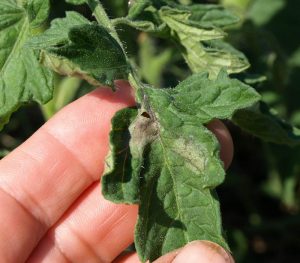
- top rot: to prevent it, you need to monitor the level of nitrogen in the soil; to avoid its increase, it is useful to introduce calcium into the soil. Still should not allow the soil to dry out and monitor the level of humidity. Affected plants can be sprayed with a solution of calcium nitrate (10 liters of water + 100 g of nitrate). Such a solution is also an excellent prophylactic against slugs and ticks;
- brown spot: so that it does not hit the plants, you should avoid waterlogging and monitor the temperature regime (which is especially important for greenhouses); regular airing is necessary. This fungal disease often affects tomatoes growing in greenhouses. Diseased plants should be sprayed with fungicides that contain copper. Spray should be for preventive purposes in early spring, before flowering, again - after a couple of weeks. To minimize the risk of disease, you should follow the rules of agricultural engineering and monitor the level of humidity, light, temperature in a closed ground.
To prevent the possibility of disease of tomatoes, it is better to take preventive measures, plant the plants correctly, respecting the distance prescribed in agricultural technology, do not thicken the planting, do not plant peppers, potatoes and other solanaceous tomatoes near the tomatoes, which have common pathogens.
Pests
 In addition to diseases, tomatoes are threatened by various pests:
In addition to diseases, tomatoes are threatened by various pests:
- thrips: you can get rid of it by spraying the bushes with Fitoverm (10 ml + 1 l of water) once every three weeks. Good help spraying herbal infusions (from dandelion, garlic, tomato tops or celandine); mustard solution (1 liter of water + 1 tsp. mustard powder) and others.
- melon melon and others: she loves to destroy a ladybug, because it is worth it to breed these bugs on your site; spraying, for example, Spark - a universal remedy against pests of garden crops; it helps tobacco infusion (1 liter of boiling water + 0.5 kg of tobacco, boil everything for 30 minutes, strain and dilute with 10 l of water), process tomatoes in the greenhouse every five days. Good aphid repel planting garlic and onions next to the tomatoes;
- slugs: they do not like ground bitter pepper, mustard, which must be diluted in water and water with a solution of soil around the bushes (10 liters of water + 1 tablespoon of pepper);
- Medvedka: in addition to irrigating the soil with pepper or mustard solution, planting Chinese carnation of tomatoes well, for example, also helps Medvetoks and other drugs against this pest.
It is always easier and easier to prevent the appearance or reproduction of pests than to try to get rid of them later. Regular routine inspections of landings are useful; in greenhouses - compliance with the level of humidity and light, as well as temperature conditions, regular ventilation and keeping the room clean, etc.
Advantages and disadvantages
Each tomato variety has its own specific advantages as well as disadvantages. And any summer gardener always takes this into account when choosing suitable varieties.
Merits
The popularity of the tomato The giant raspberry is due to many of its virtues:
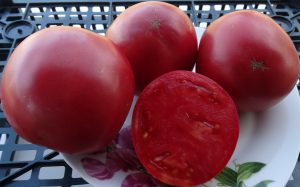
- large fruits;
- prolonged fruiting;
- high yield;
- ripening amicable;
- excellent taste and product quality;
- resistance to many diseases and pests of the nightshade;
- universality of the use of fruits;
- satisfactory keeping quality;
- resistant to cracking;
- successful transportability.
These qualities attract not only gardeners, gardeners, but also farmers, for example, because Giant raspberry successfully grown for sale.
disadvantages
Ispolina has very few of them, it is worth pointing out that:
- the variety is very demanding of the level of illumination (for closed ground);
- too sensitive to moisture and irrigation;
- the need for tying, pasynkovaniya and the formation of bushes;
Features of growing varieties
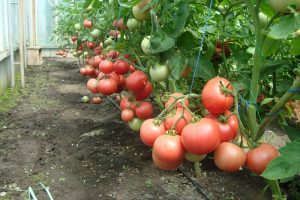 The tomato variety Giant raspberry successfully grows and bears fruit in regions with a warm climate and a large number of sunny days, because this variety requires good lighting. Therefore, for cultivation in open ground, the Giant is recommended in the following areas:
The tomato variety Giant raspberry successfully grows and bears fruit in regions with a warm climate and a large number of sunny days, because this variety requires good lighting. Therefore, for cultivation in open ground, the Giant is recommended in the following areas:
- Astrakhan;
- Belgorod;
- Voronezh;
- Saratov;
- in the Krasnodar Territory;
- in the republics of the Caucasus.
In more northern regions, crimson tomatoes Giant grow better in greenhouses.
Sowing on seedlings
Before sowing seeds in the ground, they should be prepared for planting:

- soak in a dark pink solution of potassium permanganate for 30-40 minutes;
- put the seeds in clean water for a day, change the water every 3-4 hours (so that the seeds are not suffocated);
- before sowing, you can treat the seeds with some kind of growth promoter (for example, Zircon);
- dry the seeds on a paper napkin;
- fill the tank for seedlings with nutritious soil and slightly condense it;
- plenty of water to the soil;
- spread out slightly dried seeds on the soil surface at a distance of 2-2.5 cm;
then gently sprinkle with slightly moist soil to a height of no more than 1.5 cm.
Seeds should be sown 2.5-3 months before the intended transplanting to the ground. In central Russia, this is approximately the third decade of February and the first decade of March.
See also: The best varieties of tomatoes for open ground
Growing seedlings
After the emergence of shoots shelter with containers are removed. Now the main thing: to water young sprouts in time. While they are very tiny, they should be watered carefully: from a syringe drip or spoon between the sprouts. Capacity to rearrange closer to the light.
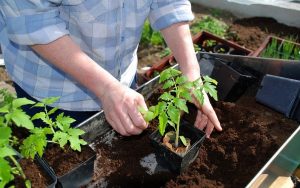 To dive or not tomatoes decides every gardener on their own. Some firmly adhere to the need for picks, others simply pour a little bit of soil between shoots. Both picking and bedding are done so that the plants form additional roots that will provide the best further development of the bushes.
To dive or not tomatoes decides every gardener on their own. Some firmly adhere to the need for picks, others simply pour a little bit of soil between shoots. Both picking and bedding are done so that the plants form additional roots that will provide the best further development of the bushes.
If you plan to plant tomatoes in open ground, the seedlings should begin to harden:
- in cloudy, warm weather, it should be carried out to the open air, gradually increasing the time of seedling on the street;
- then you can increase the stay of plants in the sun (also starting from a very short period of time);
- for the night, containers with tomatoes are still heated;
- planting bushes is also more favorable in warm, cloudy weather, if the weather is sunny, the first time after planting you need to shade the plants so that they do not get sunburn;
- Planting seedlings Giant should be at a distance of at least half a meter between the bushes, better - 70 cm; better square-nested method;
- when planting bushes, it is better to immediately install a support next to it, to which you later need to tie up the plant, so as not to disturb the root system of the tomatoes;
- planting grown shoots, they should be slightly deepened during planting.
Bushes care
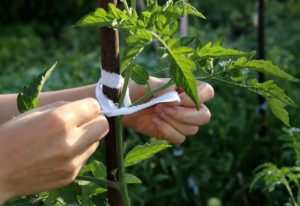 In the future, care of the tomato bushes is a regular feeding, the formation of plants, tying, pasynkovanii.
In the future, care of the tomato bushes is a regular feeding, the formation of plants, tying, pasynkovanii.
For the prevention of diseases and damage to pests of tomatoes should be regularly inspected.
Watering is necessary, avoiding drying of the top layer of soil, because Giant is very sensitive to moisture levels. Watering must be defended water in the aisle, trying not to fall on the plants themselves. To keep moisture in the soil longer and it was not necessary to water frequently, it is good to mulch the rows between rows.
If tomatoes are grown in greenhouses, it is imperative to monitor the level of humidity, light and temperature; air the premises regularly.
See also: Tomato "Brandy Pink": in detail about its advantages and disadvantages
By following the generally simple rules of agrotechnology, you can harvest a huge crop of your favorite tomatoes. The main thing is to give the plants the necessary attention and care. And then you can feast on the whole season with delicious sweet tomatoes, some of which can be prepared in order to enjoy their magnificent taste even in winter.
Video: Caring for tomatoes. First important steps


